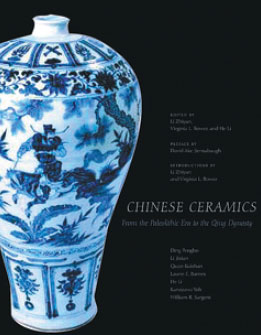A zealous Chinese culture promoter in US
Palm Beach museum curator manages to infuse a love of Chinese art in an all-American town
Laurie Barnes is one of the few people who get to do what they love, and get paid for it. She has worked for decades as a curator to promote Chinese art in Palm Beach, a southern Florida town where not so many Chinese people live. And yet Barnes, in her 60s now, feels rewarded for helping American people understand China a little more every day.
"I tell people that the 20th century is the American century, the 19th century was the British century, but the 21st century is going to be the Chinese century. So I think everyone in the world should be interested in Chinese culture because it's China's time," said Barnes.
In love with Chinese culture
When she was a kid, Barnes would go for six weeks in the summer time to her grandparents' house in the Washington D.C. area. She loved visiting museums, including her favorite Freer Gallery of Art then.
"There was just something magical about Chinese art that really spoke to me," she said. Later she decided to make it a career to learn about the objects she knew little about when she was a child and help other people appreciate them.
She started working for the Norton Museum of Art in Palm Beach in 2006 as Elizabeth B. Mcgraw curator of Chinese art, hoping to help expand the museum's Chinese collection and make them more accessible to the public.
The museum has had a Chinese collection for over half a century. Over the years, the collection grew from the initial 125 objects to about 600, ranging from delicately-carved jade, paintings, Buddha statues, and a few porcelain pieces.
Barnes said the exhibition came into being because the museum's founder Ralph Norton wanted to represent something other than Western art, and chose to focus on Chinese art.
One of Barnes' responsibilities as a curator is to present the permanent collection to visitors in an accessible way. It is not an easy job in a city that is traditionally American.
"In Chinese culture, dragons can bring good luck, they are not scary," Barnes told a group of visitors, most of whom were kids, in front of two dragon roof ridge fascia panels. They are made of earthenware, decorated with amber, the eyes of the dragon glaring in the light.
Barnes compared the dragons to "puppy dogs playing with flaming jewels," which almost immediately brought the school-aged children intimacy with this legendary animal from the Far East.
"This is my kids' first time to see this type of exhibition in a museum, I think they are enjoying it, the dragons are cool for my son," said Fabiola Williams, a young mother visiting with her two kids.
"If you can get people to start looking, and give them some information, create a story around it, they will enjoy it," said Barnes, adding that she tried to engage a wide spectrum of people.
The museum launches special programs on important Chinese holidays such as the Chinese New Year and the Mid-Autumn Festival.
Scott Benarde, the museum's director of communication, told Xinhua that over 2,000 people came in one day for the Chinese New Year last time, while 600 or 700 people came for the Mid-Autumn festival.
"I would say people are interested," said Benarde. "It "s hard not to walk into our Chinese collection and look at that giant head of a Buddha, and just not be awed and thrown, no matter who."
Making Chinese culture more exciting
However, Barnes still sees visitors walking past precious objects not knowing the value in them. To make Chinese art more exciting, she also launches special exhibitions and lecture series that highlight the collection.
She once ran an exhibition on the impact of tea culture worldwide since many of her favorite pieces of ceramics are connected with tea.
She chose eight tea countries to focus on but emphasized China's influence.
"In terms of the impact of tea and impact of ceramics, to my mind, all roads lead back to China, and I made the exhibition that way," she said.
The exhibition was well-received. "There are still people coming up to the entrance desk and saying 'who did that exhibition. I'll never forget it. It was one of the greatest exhibitions I've ever seen,'" Barnes said.
She spent three years of her life on it and felt really gratified to have that kind of public response.
Barnes also likes to talk about a rabbit pendant made of jade in public tours.
"It's so tiny that people would never look at it unless I do. So I try to tell people how it would have been used, who would have used it, why jade is important to the Chinese people," she said.
If she's not in the exhibition hall talking and answering questions, she will be in the office to study more about each object.
Her office is a wonderland for anyone interested in art. In just five square meters, she fit in as many Chinese elements as possible.
The wooden floor has a bamboo layer on it, which reminds one of the decorations of a traditional Chinese tea house. A gongfu tea set was placed on the table beside the computer while several porcelain tea cups and mini zisha (purple clay) tea pots were laid out neatly on the bookshelf.
The books, including ones on ceramics that she published, art auction catalogs, and Chinese art and history chronicles, took the rest of the space.
Closer US-China cultural exchanges in recent years have made Barnes' research work more exciting.
The museum's Chinese collection comes primarily from dealers in the early 20th century without context. Sometimes the curators are not sure whether an object is real or fake. The important archaeological discoveries in China in recent years have been incredibly helpful for Barnes to study the collection.
"The excavation of imperial kilns in Jingdezhen really changed our understanding of 14th century and early 15th century ceramics," said Barnes.
She is now working on an exhibition of porcelain from Jingdezhen, a city in China's Jiangxi province famous for porcelain making, looking for ways to tackle the challenge that the American public don't know how to appreciate broken pieces.
"I think with anything, if you can get people to start looking, and give them some information, create a story around it, they will enjoy it," said Barnes.
Xinhua
|
Chinese Ceramics: From the Paleolithic Period through the Qing Dynasty. Provided To China Daily |



















